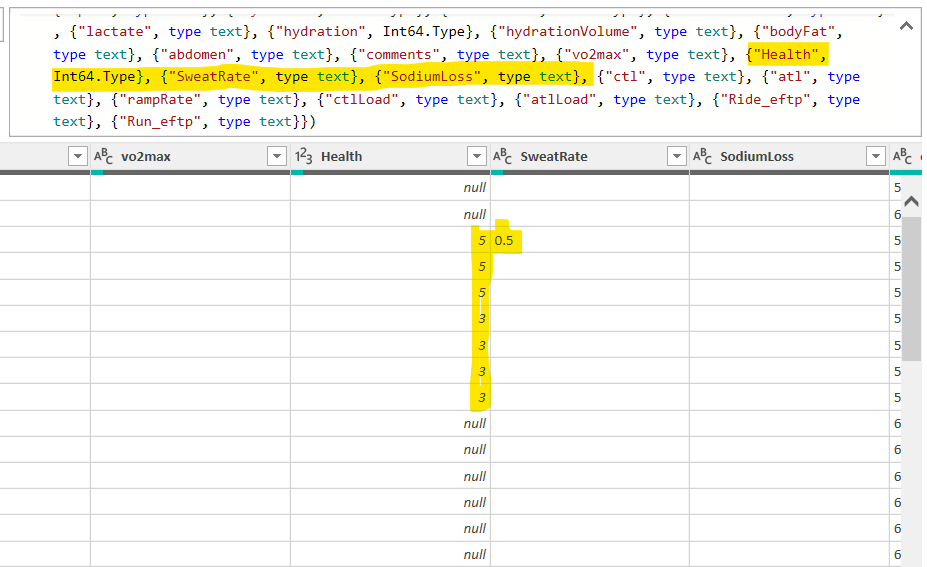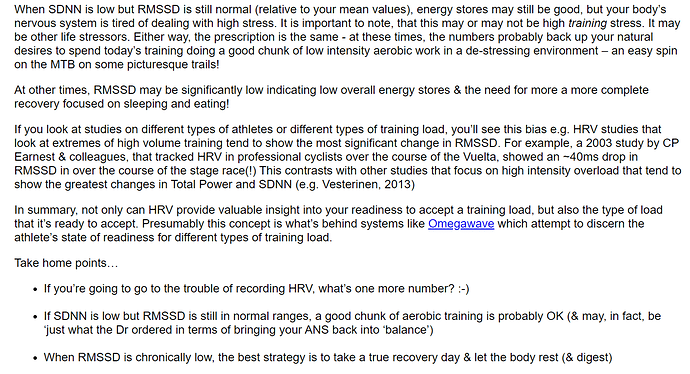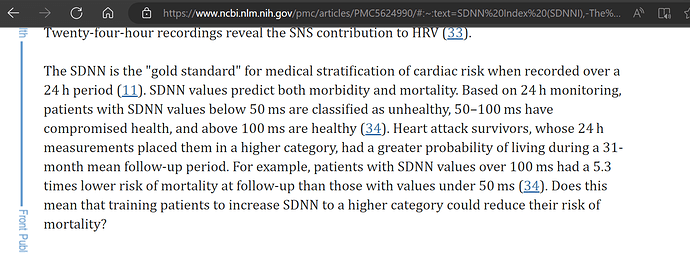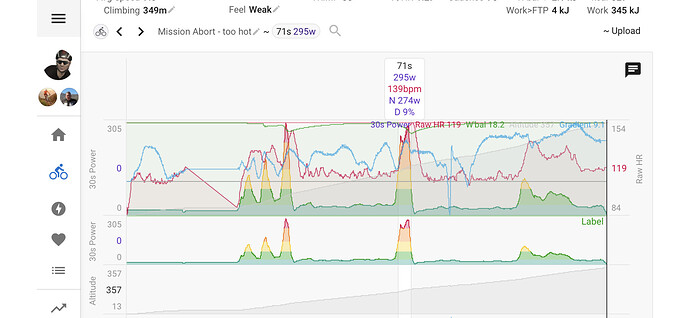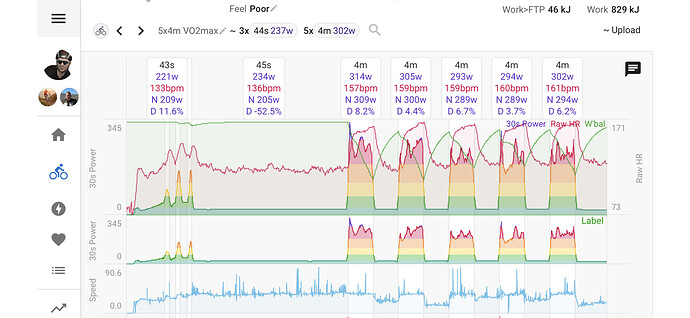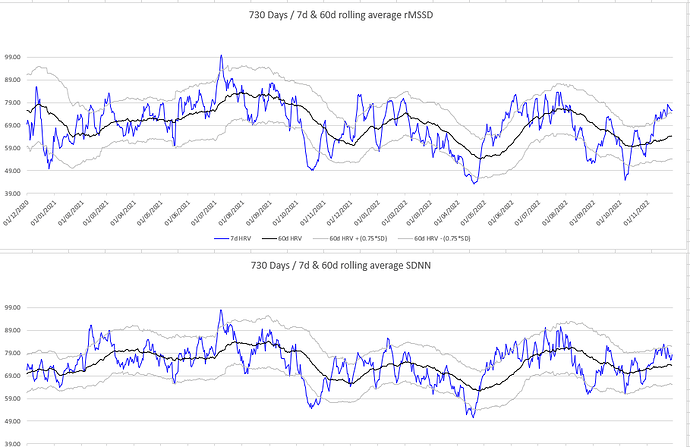You mean in the full featured API-Tools excel?
I just tried that and I’m still only getting the standard intervals columns.
The only way I found to access the custom fields, is by making an API call with curl and specifying all columns by name.
Yes, the Excel file. I’m still using my original Excel file that I use for my ATP, and have copied the iThlete file into my spreadsheet.
I deleted the connections and then created them from new. It then worked.
When I try copy the command in the Power Query Editor, it gives an error.
That’s my workaround solution.
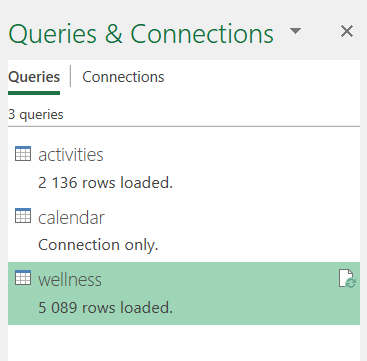
You can add -v key to get verbose logging and have more information on the error like this:
curl.exe -v -u…

7 day HRV decreasing (trend is downward anyway), 7 day rHR decreasing and 7 day CV% decreasing. What bucket does this fall into? LOL. Saturation???
Just as HRV and rHR need to be evaluated against your normal values, you also need to evaluate what can be considered an increase or a decrease or a stable situaion. To do that, the 14d trend (Marco calls this ‘recent trend’) must be calculated and for HRV and rHR you need to evaluate 30d rolling avg and SD for the slope of the recent trend. Any increase or decrease falling into the range avg +/- 1 SD is to be considered stable.
Something similar must be done for CV. It’s not simply increase or decrease, there is a zone considered stable and it’s based on your personal historical values, no hard numbers equal for everyone.
Complicated enough? Give us some time to digest all this and we will come up with a mathematical solution. Unless you come up with one before us 
Your idea above of increase/decrease isn’ going to cut it. It’s a fair bit more difficult. And I want to do it following the advice of people with years of experience and research data for thousands of athletes.
Underneath article was posted yesterday and gives an idea of how much data is needed and how much time, knowledge and mathematical insight you must have to filter meaningfull correlations.
All those articles posted by @Howie and @MedTechCD are very interesting and informative. Thanks for sharing.
Overtraining: Using HRV effectively 3| Alan Couzens
See screenshot below from the Alan Couzens blog (link above)
We know that normal range for rMSSD is 60d average +/- 0.75*60dSD and it’s our 7 day average used as a baseline
Does anyone know what the SDNN baseline and ranges are? Are the calculated the same way as rMSSD?
There is not much to find on SDNN, believe me, I’ve searched…
All I have is 2 specific conditions but difficult to interpret.
Here’s what Marco found:
In most cases SDNN reacts very similar to rMSSD. But there are a few occasions where there is a difference. And that difference points to a specific situation. If you want to try out the iThlete file with SDNN, it’s just one formula to change and point to the SDNN in the wellness sheet.
To guide the training you would have to use all the metrics derived from the HRV, to simplify the rMSSD is used, I have read a lot of medical papers about all this and in medicine the SDNN is used a lot as an indicator, I normally use rmssd, sdnn, hf, lf when I have any doubt about how to act that day.
Can you elaborate a little here please if you don’t mind?
I use EliteHRV and the tracker from here but recently have been doing a lot more reading on this subject. Often the ‘Readiness’ reading will give me the go ahead for training when I’m obviously not able for it, like today for example where I’m fighting a small throat infection.
EliteHRV gives me a green light (readiness score of 9) and the tracker from here is as per screenshot below.

However I’m 100% not able for even a Tempo session today.
What I am wondering is whether to do a light recovery 30m leg spin.
There is a big difference in LF/HF ratio which is probably something to take into consideration. Ratio of 3.90
LF Power 5377.07 ms²
HF Power 1378.61 ms²
How do you use SDNN, LF and HF powers to help you make a more informed decision than simply taking the readiness score the apps spit out?
What is readiness calculated from in EliteHRV?
Don’t you have rMSSD or SDNN or a log transformed value of the pure measurement?
Readiness scores are often already an ‘interpretation’ taking subjective scores and/or load in account.
The chart will only function reasonably well with good quality raw measured rMSSD or SDNN.
Exactly. They transform the measurement of the rMSSD value. Kind of like what HRV4Training do. The chart we have here and EliteHRV almost always marry up. Slight differences some days but nothing drastic.
Those charts and readiness scores though are limited in the readiness score they produce. That’s why I’m looking for more info on a deeper analysis.
Alan Couzens wrote a blog before where he says that if rMSSD is within normal range but SDNN falls below normal range for any given day that chances are your body will respond well to aerobic training
Don’t neglect how you “feel” on the day, over what a metric tells you, and vice versa. If you feel bad, but the metric says “proceed as planned, or HIT” then start the workout. A workout should always include a short warmup, with some 30-60s high cadence spins (3-5 times at +/- 80-100% of FTP). This serves as a warmup as well as an indicator if you are up for the workout, or not. If you still feel bad after the last warmup effort, then you know to possible reduce the intensity and keep it easy. If you feel okay, then you can continue. That way you won’t lose out on a potential good workout. BUT… there’s a usual “it depends” caveat. In many cases, above the throat is usually considered okay, and anything below is a no-go. You have to develop the “feel” and know what happened before, which is why making notes, using RPE, Feel as well as matching the data (metrics) helps make your decision to train easier.
If you plan to continue doing a set of intervals, then see how you feel after each interval. If you’re struggling to hold the power/pace then it’s also a sign to possibly stop. If you feel okay, and can complete the interval, look to complete the next one.
I’ve had sessions where I felt bad, but the data said otherwise. If I had followed the advice, I would have missed a good workout. If I feel bad, and still can’t complete and short warmup, then I make a call to call it a day, or just ride easy.
Here’s an example of an aborted workout, plus comments about it being too hot (indoor workout, ambient temperature = 32°C). I quit the activity after struggling to hold 280W for just over a minute, and also struggling to hold a tempo effort for a few seconds. The planned workout was 5x5m at +/- 300W. The iThlete chart showed “train as planned”, close to HIT, but above the horizontal line. The previous day was orange (I did a 2x20m Z2 endurance ride (70-74%), with the rest just above Z1). So while I felt terrible, and the metrics showed otherwise. I don’t perform well in the heat, so the decision to cut the workout short was an easy one to make.
Then, a day when I felt poor, but the data said “train as planned”, close to HIT, I decided to do as much as I could. After the 3rd interval I wanted to stop. I then said one more interval, and after the 4th I said just one more. Ended it as planned, although in the lower half of Z5 (VO2) instead of the upper half.
100% agree. I will always or nearly always ‘listen to my body’ .
What I am trying to say I guess is that there is a lot more for us to discover from HRV data. We’re only at the tip of the iceberg when taking these readiness scores from whatever app we’re using.
My last block (3 week block) involved a lot of switching of sessions, depending on HRV data and subjective data. Missed one session (HRV gave the green light) but I just knew deep down that doing the session that day would have been a disaster of an idea.
There is a lot to learn about interpretation of HRV data. That article by Alan Couzens piqued my interest. It’s not even about whether a session can go ahead - it’s about what type of session my body is most likely best able to cope with on a day. If I get an rMSSD in normal range but an SDNN lower than normal range I might get a green light for any type of session and I might feel I can take on any type of session. But in an instance such as is outlined above, evidence shows my body will most likely respond better to an aerobic workout
You probably have a very high rmssd and the pulse is in its zone or rather low, so this algorithm is going to tell you to train, here now something is going to happen and that is that you are going to have a very high or very low sDNN, it will probably be out of its range, which means that it is possible that you are in the process of recovery or that you are not recovered, it depends on the value, LF refers to “sympathetic power” and HF to “parasympathetic power” so in your case it is possible that you may have a high rmssd, a low sdnn, which means that you are not ready to take a training and maybe you need a rest or an active recovery day. I say all this without looking at your historical data, as an advice I would say that you should switch to HRV4training as you could graph in intervals.
Blue = 7d average, Black = 60d average, Grey lines = 0.75*SD
30d average for rHR + 7 day baseline.
I did a 38 minute light session and left it at that with a load of just 33
What session did you do before that reading? It seems as if you have not recovered from the previous session.
Recovery week last week and Sunday and Monday off the bike. But, sore throat yesterday and quite tired this morning. Definite infection of some kind but it’s not severe.
But regardless of what any HRV readings told me today I going by subjective feel because of the sore throat. Kept it to a really light session.
It’s the interpretation of the LF and HF values I’m interested in and how you use those to help make an informed decision when you’re not quite sure what to do.
Are you looking for a balance between LF/HF? Are you looking for the ratio between those to be less than 2?
If I were your coach with the data you have from hrv and without knowing your feelings I would have made you stop. Subjective perceptions are also very important and even more so when we base hrv values only on rmssd. Many authors like Altini don’t use the sdnn because it is possible to cheat it if you know how, but as a general rule nobody knows how to cheat it. I always value all values, elite hrv I think calculates lf and hf as ms2 so the ratio is going to be different than what Couzens is explaining with Kubios.
